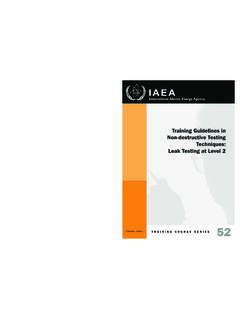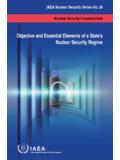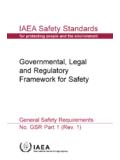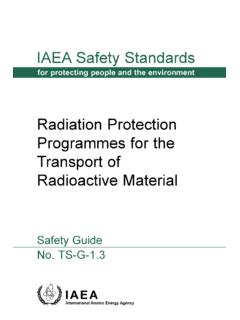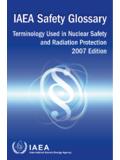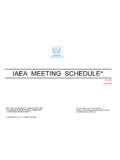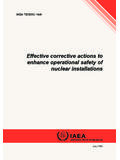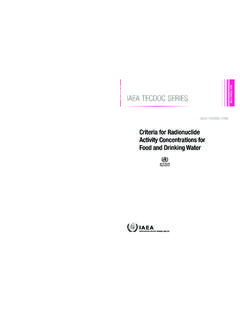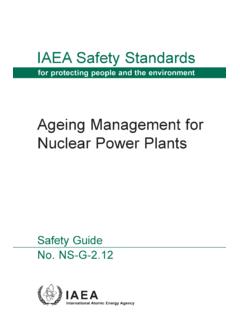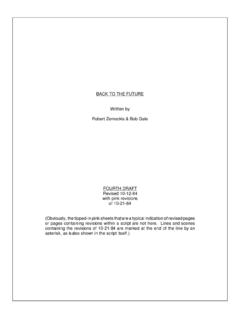Transcription of INSAG-7 The Chernobyl Accident - IAEA
1 SAFETY SERIES No. 75-INSAG-7inLLCOINSAG-7 The Chernobyl Accident :Updating of INSAG-1A REPORT BY THEINTERNATIONAL NUCLEAR SAFETY ADVISORY GROUPINTERNATIONAL ATOMIC ENERGY AGENCY, VIENNA, 1992 CATEGORIES IN THE IAEA SAFETY SERIESA new hierarchical categorization scheme has been introduced, according towhich the publications in the IAEA Safety Series are grouped as follows:Safety Fundamentals (silver cover)Basic objectives, concepts and principles to ensure Standards (red cover)Basic requirements which must be satisfied to ensure safety for particularactivities or application Guides (green cover)Recommendations, on the basis of international experience, relating to the ful-filment of basic Practices (blue cover)Practical examples and detailed methods which can be used for the applicationof Safety Standards or Safety Fundamentals and Safety Standards are issued with the approval of theIAEA Board of Governors.
2 Safety Guides and Safety Practices are issued under theauthority of the Director General of the additional category, Safety Reports (purple cover), comprises independentreports of expert groups on safety matters, including the development of new princi-ples, advanced concepts and major issues and events. These reports are issued underthe authority of the Director General of the are other publications of the IAEA which also contain informationimportant to safety, in particular in the Proceedings Series (papers presented atsymposia and conferences), the Technical Reports Series (emphasis on technologicalaspects) and the IAEA-TECDOC Series (information usually in a preliminary form).THE Chernobyl Accident : UPDATING OF INSAG-1 INSAG-7A report by the International Nuclear Safety Advisory GroupThe following States are Members of the International Atomic Energy Agency.
3 AFGHANISTANALBANIAALGERIAARGENTINAAUSTRA LIAAUSTRIABANGLADESHBELARUSBELGIUMBOLIVI ABRAZILBULGARIACAMBODIACAMEROONCANADACHI LECHINACOLOMBIACOSTA RICACOTE D'lVOIRECUBACYPRUSCZECHOSLOVAKIADEMOCRAT IC PEOPLE'SREPUBLIC OF KOREADENMARKDOMINICAN REPUBLICECUADOREGYPTEL SALVADORESTONIAETHIOPIAFINLANDFRANCEGABO NGERMANYGHANAGREECEGUATEMALAHAITIHOLY SEEHUNGARYICELANDINDIAINDONESIAIRAN, ISLAMIC REPUBLIC OFIRAQIRELANDISRAELITALYJAMAICAJAPANJORD ANKENYAKOREA, REPUBLIC OFKUWAITLEBANONLIBERIALIBYAN ARAB JAMAHIRIYALIECHTENSTEINLUXEMBOURGMADAGAS CARMALAYSIAMALIMAURITIUSMEXICOMONACOMONG OLIAMOROCCOMYANMARNAMIBIANETHERLANDSNEW ZEALANDNICARAGUANIGERNIGERIANORWAYPAKIST ANPANAMAPARAGUAYPERUPHILIPPINESPOLANDPOR TUGALQATARROMANIARUSSIAN FEDERATIONSAUDI ARABIASENEGALSIERRA LEONESINGAPORESLOVENIASOUTH AFRICASPAINSRI LANKASUDANSWEDENSWITZERLANDSYRIAN ARAB REPUBLICTHAILANDTUNISIATURKEYUGANDAUKRAI NEUNITED ARAB EMIRATESUNITED KINGDOM OF GREATBRITAIN AND NORTHERNIRELANDUNITED REPUBLIC OFTANZANIAUNITED STATES OF AMERICAURUGUAYVENEZUELAVIET NAMYUGOSLAVIAZAIREZAMBIAZIMBABWEThe Agency's Statute was approved on 23 October 1956 by the Conference on the Statute of theIAEA held at United Nations Headquarters, New York; it entered into force on 29 July 1957.
4 The Head-quarters of the Agency are situated in Vienna. Its principal objective is "to accelerate and enlarge thecontribution of atomic energy to peace, health and prosperity throughout the world". IAEA, 1992 Permission to reproduce or translate the information contained in this publication may beobtained by writing to the International Atomic Energy Agency, Wagramerstrasse 5, Box Vienna, by the IAEA in AustriaNovember 1992 SAFETY SERIES No. 75- INSAG-7 THE Chernobyl Accident :UPDATING OF INSAG-1 INSAG-7A report by theInternational Nuclear Safety Advisory GroupINTERNATIONAL ATOMIC ENERGY AGENCYVIENNA, 1992 The International Nuclear Safety Advisory Group (INSAG) is an advisorygroup to the Director General of the International Atomic Energy Agency, whosemain functions are:(1) To provide a forum for the exchange of information on generic nuclear safetyissues of international significance;(2) To identify important current nuclear safety issues and to draw conclusions onthe basis of the results of nuclear safety activities within the IAEA and of otherinformation;(3) To give advice on nuclear safety issues in which an exchange of informationand/or additional efforts may be required.
5 (4) To formulate, where possible, commonly shared safety SAFETY SERIES IS ALSO PUBLISHED INFRENCH, RUSSIAN AND SPANISHVIC Library Cataloguing in Publication DataThe Chernobyl Accident : updating of INSAG-1 : INSAG-7 : a report by theInternational Nuclear Safety Advisory Group. Vienna : InternationalAtomic Energy Agency, ; 24 cm. (Safety series, ISSN 0074-1892 ; 75- INSAG-7 )STI/PUB/913 ISBN 92-0-104692-8 Includes bibliographical Chernobyl Nuclear Accident , Chernobyl , Ukraine, 1986. I. Inter-national Atomic Energy Agency. II. International Nuclear Safety AdvisoryGroup, n. 92-00042 FOREWORDby the Director GeneralNew information that has come to light since the Post- Accident Review Meet-ing on the Chernobyl Accident (held in Vienna from 25 to 29 August 1986) bearson general issues of the operational safety of nuclear power plants in the then Unionof Soviet Socialist Republics as well as on specific issues relating to the design ofthe Chernobyl type light water cooled, graphite moderated RBMK regards general issues, the new information demonstrates the lack of feed-back of operating experience and the inadequacy of communication betweendesigners, engineers, manufacturers, constructors, operators and regulators.
6 Thesedeficiencies, coupled with a lack of clear lines of responsibility, were critical factorsin the events leading up to the Chernobyl Accident . These shortcomings have beentackled at the national level and some improvements have been lessons can be learned from incidents and accidents, as was demon-strated after the Accident at Three Mile Island nuclear power plant in the UnitedStates of America in 1979, when far reaching follow-up actions were taken tominimize the risk of a recurrence and to improve procedures for Accident manage-ment. The Accident at Chernobyl demonstrated that the lessons from the Three MileIsland Accident had not been acted upon in the USSR: in particular, the importanceof systematic evaluation of operating experience; the need to strengthen the on-sitetechnical and management capability, including improved operator training; and theimportance of the man-machine issues relating to the design of the RBMK reactors were the subjectof intensive studies in the USSR after 1986, and some modifications have since beenmade to these reactors and to their operating regimes.
7 More recently, discussionshave been held at the international level on the safety of nuclear power plants withRBMK reactors. International efforts to assist in the safety assessment of the RBMK reactors have been intensified in recent to enhance the safety of RBMK reactors will continue; however, inter-national assistance can only achieve a fraction of what has to be done at the nationallevel. In addition, the general issues mentioned earlier require sustained efforts toupgrade the national nuclear safety regime before a safety culture can be inculcatedat all levels and in all the organizations emergence of the new information prompted the IAEA's InternationalNuclear Safety Advisory Group (INSAG) to review its former conclusions about thecauses of the Chernobyl Accident of April 1986. The present INSAG-7 report updatesthe Summary Report on the Post- Accident Review Meeting on the Chernobyl Acci-dent (IAEA Safety Series No.)
8 75-INSAG-l), published in September 1986. The con-clusions formulated in the report will broaden the basis for internationalconsultations to enhance the safety of RBMK this report, INSAG has made a valuable contribution to the task that NOTEA lthough great care has been taken to maintain the accuracy of information containedin this publication, neither the IAEA nor its Member States assume any responsibility forconsequences which may arise from its use of particular designations of countries or territories does not imply any judge-ment by the publisher, the IAEA, as to the legal status of such countries or territories, of theirauthorities and institutions or of the delimitation of their authors are responsible for having obtained the necessary permission for the IAEAto reproduce, translate or use material from sources already protected by prepared by authors who are in contractual relation with governments iscopy righted by the IAEA, as publisher, only to the extent permitted by the appropriate INTRODUCTION 12.
9 FEATURES OF THE REACTOR Void coefficient of reactivity Design of control and safety rods Speed of insertion of the emergency protection rods Control of power Instrumentation indicating the reactivity margin Size of the reactor core Capability to alter safety systems, plant trips and alarms Subcooling of the inlet water Primary coolant system Containment 83.
10 THE Accident 104. MORE RECENT ANALYSES OF THE FAULT SCENARIO The scenario Operating reactivity margin 145. VIEWS OF INSAG Design Operator actions Safety framework Implications of ignoring deficiencies Importance of competent safety analysis Deficiencies in the regulatory regime General remarks on the lack of safety culture Summary assessment 226.
